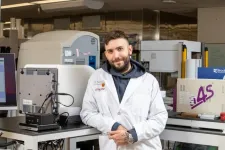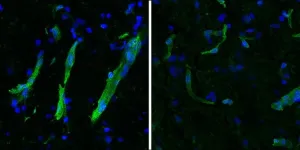(Press-News.org)
Attention editors: Under embargo by the journal Nature Machine Intelligence until Friday, March 22, 12 p.m. eastern
Hamilton, ON, Mar. 22, 2024 – Researchers at McMaster University and Stanford University have invented a new generative artificial intelligence model which can design billions of new antibiotic molecules that are inexpensive and easy to build in the laboratory.
The worldwide spread of drug-resistant bacteria has created an urgent need for new antibiotics, but even modern AI methods are limited at isolating promising chemical compounds, especially when researchers must also find ways to manufacture these new AI-guided drugs and test them in the lab.
In a new study, published today in the journal Nature Machine Intelligence, researchers report they have developed a new generative AI model called SyntheMol, which can design new antibiotics to stop the spread of Acinetobacter baumannii, which the World Health Organization has identified as one of the world’s most dangerous antibiotic-resistant bacteria.
Notoriously difficult to eradicate, A. baumannii can cause pneumonia, meningitis and infect wounds, all of which can lead to death. Researchers say few treatment options remain.
“Antibiotics are a unique medicine. As soon as we begin to employ them in the clinic, we're starting a timer before the drugs become ineffective, because bacteria evolve quickly to resist them,” says Jonathan Stokes, lead author on the paper and an assistant professor in McMaster’s Department of Biomedicine & Biochemistry, who conducted the work with James Zou, an associate professor of biomedical data science at Stanford University.
“We need a robust pipeline of antibiotics and we need to discover them quickly and inexpensively. That's where the artificial intelligence plays a crucial role,” he says.
Researchers developed the generative model to access tens of billions of promising molecules quickly and cheaply.
They drew from a library of 132,000 molecular fragments, which fit together like Lego pieces but are all very different in nature. They then cross-referenced these molecular fragments with a set of 13 chemical reactions, enabling them to identify 30 billion two-way combinations of fragments to design new molecules with the most promising antibacterial properties.
Each of the molecules designed by this model was in turn fed through another AI model trained to predict toxicity. The process yielded six molecules which display potent antibacterial activity against A. baumannii and are also non-toxic.
"Synthemol not only designs novel molecules that are promising drug candidates, but it also generates the recipe for how to make each new molecule. Generating such recipes is a new approach and a game changer because chemists do not know how to make AI-designed molecules,” says Zou, who co-authored the paper.
The research is funded in part by the Weston Family Foundation, the Canadian Institutes of Health Research, and Marnix and Mary Heersink.
-30-
Media contacts at McMaster University:
Michelle Donovan
Associate Director, Media Relations
McMaster University
donovam@mcmaster.ca
(c) 905-512-8548
END
UNIVERSITY PARK, Pa. — Eating one avocado per day may improve overall diet quality, according to a team led by researchers in Penn State’s Department of Nutritional Sciences. Poor diet quality is a risk factor for many diseases, including heart disease, and many American adults have poor diet quality and do not meet key dietary recommendations provided by the Dietary Guidelines for Americans.
This study was led by Kristina Petersen, associate professor of nutritional sciences, and Penny ...
AURORA, Colo. (March 22, 2024) – The health impacts of a complex protein that plays a major role in the development of Alzheimer’s disease and heart conditions can be lessened by three kinds of drug inhibitors, according to scientists at the University of Colorado Anschutz Medical Campus.
In an overview of the protein and the inhibitors published today in the journal Cell Reports, the CU researchers discussed the best ways to use the interventions.
The protein, CaMKII, is ubiquitous in cells throughout the body but is perhaps best known for its prominent role in the brain and the heart. It is critical in learning and memory but if misregulated can ...
From photons to atheism to Churchill’s extraterrestrial musings, the stunning breadth of Carlo Rovelli’s work has spurred readers to think deeply about the intersection of science and culture, transforming staggering complexity into widely accessible writing along the way.
For this artful ability to educate and engage, Rovelli will be presented with the 2024 Lewis Thomas Prize for Writing about Science at The Rockefeller University on April 9. Named after its first recipient, noted physician-scientist and essayist Lewis Thomas, the prize was ...
It’s no surprise that your dog can learn to sit when you say “sit” and come when called. But a study appearing March 22 in the journal Current Biology has made the unexpected discovery that dogs generally also know that certain words “stand for” certain objects. When dogs hear those words, brain activity recordings suggest they activate a matching mental representation in their minds.
“Dogs do not only react with a learned behavior to certain words,” says Marianna Boros (@FamDogProject) of the Department of Ethology at the Eötvös Loránd University, Budapest, Hungary, one of the paper’s co-first authors. “They also don’t ...
It’s no surprise that dogs can learn to understand and respond to human words. Your dog can learn to sit when you say “sit” and come when called. But a new study has made the surprising discovery by recording brain activity that dogs generally also know that certain words “stand for” certain objects. When they hear those words, they activate a matching mental representation in their minds.
“Dogs do not only react with a learned behavior to certain words,” says Marianna Boros of the Department of Ethology at the Eötvös Loránd University, Budapest, Hungary. “They also don’t just associate that word with an object ...
CNIO researchers provide a new hypothesis to understand the origin of amyotrophic lateral sclerosis, or ALS. It would be triggered by a similar problem to that occurring in a group of rare diseases called ribosomopathies.
In ALS patients, motor neurons would accumulate an excess of non-functional ribosomal proteins that eventually collapse the cell's clearance systems and cause toxicity.
The study also opens a new front in aging research. The authors provide experimental evidence that formally proves a kind of stress called ‘nucleolar stress’ cause aging in mammals.
Amyotrophic lateral sclerosis (ALS) is a degenerative disease. ...
On the surface, the movement disorder amyotrophic lateral sclerosis (ALS), also known as Lou Gehrig’s disease, and the cognitive disorder frontotemporal lobar degeneration (FTLD), which underlies frontotemporal dementia, manifest in very different ways. In addition, they are known to primarily affect very different regions of the brain.
However, doctors and scientists have noted several similarities over the years, and a new study in Cell reveals that the diseases have remarkable overlaps at the cellular and molecular levels, revealing potential targets that could yield therapies applicable ...
About The Study: In this study of 5,437 U.S. adults with health care visits in 2022, many patients, including those with the greatest care needs, chose telemedicine even after in-person visits were available. These findings support continuing this care delivery approach as an option valued by patients. Differences were not observed by most common measures of socioeconomic status. Continued monitoring of telemedicine use is needed to ensure equitable access to health care innovations.
Authors: Eva ...
About The Study: The results of this study of Medicare enrollees suggest that although nationally, Black and Hispanic individuals and individuals of other racial groups received more telemedicine visits during the pandemic and disproportionately lived in geographic regions with higher telemedicine use, after controlling for geographic region, Black and Hispanic individuals and individuals of other racial groups received fewer telemedicine visits than white individuals.
Authors: Felippe O. Marcondes, M.D., M.P.H., of Massachusetts General ...
More than half of all new doctors face some form of sexual harassment in their first year on the job, including nearly three-quarters of all new female doctors and a third of males, a new study finds.
That’s actually down somewhat from the percentage of new doctors who experienced the same five or six years before, according to the paper published in JAMA Health Forum by a team from the University of Michigan Medical School and Medical University of South Carolina.
And today’s ...





